Armed with gloves, rubber boots and a rake, “Mangrove Warrior” Willer Gualva, 68, comes to Freedom Island in the Philippines almost every day to stop it being engulfed by trash.
No one lives on the island, yet each morning its shores are covered in garbage, much of it single-use sachets of shampoo, toothpaste, detergent and coffee that are carried out to sea by the rivers of overcrowded Manila.
“We collect mostly plastics here and the number one type are sachets,” said Gualva, one of 17 people employed by the Philippine Department of Environment and Natural Resources to help preserve the island and its forest.
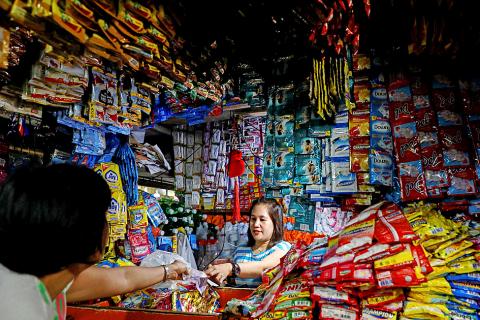
Photo: Reuters
The department calls them “Mangrove Warriors” and pays them slightly above US$8 per day.
Five days of coastal cleanup on the Manila Bay island last month yielded a total of 16,000kg of trash, department data showed, the bulk of it plastics, including the sachets made of aluminum and blends of plastics.
These packets give some of the poorest people in Asia access to everyday household essentials. For the multinationals that manufacture them, it is a way to increase sales by targeting customers who cannot afford bigger quantities.
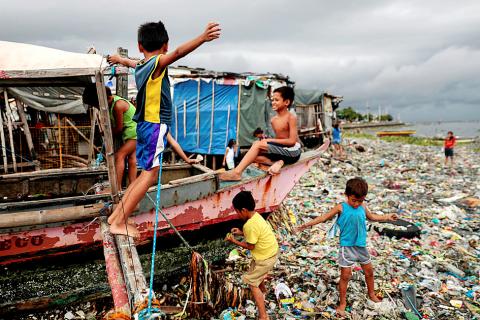
Photo: Reuters
Such sachets are sold in most developing countries, but the number consumed in the Philippines is staggering — 163 million pieces a day, according to a recent study by environmental group The Global Alliance for Incinerator Alternatives (GAIA).
That is almost 60 billion sachets a year, or enough to cover 130,000 soccer fields.
In Manila’s slum areas, which are inaccessible to garbage trucks, sachets and other waste are thrown in estuaries or dumped on the street, and end up clogging drains and waterways.
“Money is hard to come by, so I only buy sachets,” said Lisa Jorillo, 42, a mother of four who lives in a slum in Manila’s Tondo area, behind a beach blanketed by trash.
“It’s likely the garbage will still be there when my son grows up,” Jorillo said, referring to her four-year-old.
The Philippines’ law on solid waste is poorly enforced and the country does not regulate packaging manufacturing.
The country is ranked third in the world for failing to deal with its plastics, according to a 2015 study by the University of Georgia, which said 81 percent of plastics waste in the nation was mismanaged.
About 14 million people live in Metro Manila, one of Asia’s teeming mega-cities. Overall, the Philippines has a population of 107 million people, and one-fifth of them live below the national poverty line, described by the statistics agency as monthly consumption of less than US$241 per person.
Jorillo’s family earns about 2,500 pesos (US$48) a week from the construction work that her husband does, and she and her family buy about 80 sachets of coffee, toothpaste and shampoo each month.
In sea-facing Manila, much of the trash ends up in the sea.
The Philippines, Indonesia, Thailand, Vietnam and China account for 60 percent of the world’s marine plastic, or 8 million tonnes annually, the nonprofit Ocean Conservancy said.
Environmentalists say the main culprits are not governments or consumers, but the multinationals that churn out plastic packaging.
“They have money to do research that will remove the problematic packaging,” said Sonia Mendoza, head of the Mother Earth Foundation, which promotes waste reduction.
She said refilling stations could be one way to reduce the use of single-use sachets.
GAIA studied non-recyclable waste collected in Philippine cleanups and found that 60 percent of it came from just 10 companies, led by Nestle, Unilever and Procter & Gamble.
Nestle declined to disclose the volume of sachets it produced or sold in the Philippines.
Nestle said it was committed to finding ways to keep plastics out of oceans through plastic collection and recycling programs, but added that sachets prevented leakage of micro-nutrients essential to addressing malnutrition, especially among children.
Unilever did not say how many sachets it produces in the Philippines, but said its global plastic packaging production is 610,000 tonnes annually.
The figure includes “flexible packaging formats” used by 1 million micro-businesses in the Philippines, it said.
Nestle and Unilever’s target is for 100 percent of their packaging to be recyclable or reusable by 2025 worldwide.
Unilever said it has a community-based sachet recovery program in the Philippines where collected sachets are converted to school chairs and cement pavers.
It also pilot ran shampoo and conditioner refilling stations this year, which it plans to scale up.
P&G referred questions to the industry group Philippine Alliance for Recycling and Materials Sustainability (PARMS) or the government’s National Solid Waste Management Commission.
The Philippine government does not have a clear strategy to tackle its plastics crisis.
In an e-mailed response to Reuters, the department said it was in discussions with all manufacturers to identify ways to manage waste. It provided no details.
Elsewhere in the region, Indonesia has a law requiring producers to manage non-biodegradable packaging and the tourist island of Bali bans single-use plastics.
Thailand is between now and 2025 introducing bans on seven types of plastics most commonly found in the ocean, like bottle cap seals, disposable bags, cups and straws.
Vietnam hopes to raise taxes on plastic bags and its prime minister has urged shops to stop using non-recyclable plastics in cities by 2021, and nationwide by 2025.
The Philippines industry group PARMS, which includes Unilever, P&G and Nestle among its members, is building a 25 million pesos facility that aims to turn sachets into plastic blocks and eco-bricks.
However, Von Hernandez, global coordinator for the Break Free From Plastic movement, calls that “greenwashing” — or only trying to appear more environmentally friendly.
“They are not really changing the true nature of their business,” Hernandez said of the multinationals. “The plastics industry is slated to grow exponentially, especially by 2030. The bulk of that is going to packaging and you can bet this is going to end up in sachets.”
PARMS president Crispian Lao said that every effort, even those which “may be perceived as small and insignificant,” helps address the problem.
Lao said sachets were a necessity for lower-income groups, but added the industry is exploring other delivery formats and packaging alternatives.
Philippine Senator Cynthia Villar said she is pushing for a radical rewrite of an existing waste law to force firms to collect, recycle and dispose of all single-use plastics they produce.
“They always say they’re willing to do it, but it’s a different story altogether whether they’ll do it, so we have to embody it in a law so they’ll all follow,” Villar said.
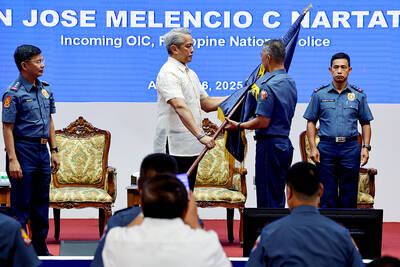
Philippine President Ferdinand Marcos Jr has fired his national police chief, who gained attention for leading the separate arrests of former Philippine president Rodrigo Duterte on orders of the International Criminal Court and televangelist Apollo Carreon Quiboloy, who is on the FBI’s most-wanted list for alleged child sex trafficking. Philippine Executive Secretary Lucas Bersamin did not cite a reason for the removal of General Nicolas Torre as head of the 232,000-member national police force, a position he was appointed to by Marcos in May and which he would have held until 2027. He was replaced by another senior police general, Jose
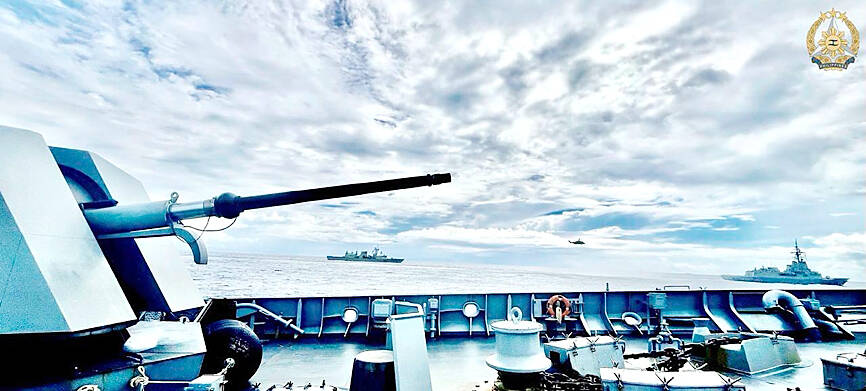
STILL AFLOAT: Satellite images show that a Chinese ship damaged in a collision earlier this month was under repair on Hainan, but Beijing has not commented on the incident Australia, Canada and the Philippines on Wednesday deployed three warships and aircraft for drills against simulated aerial threats off a disputed South China Sea shoal where Chinese forces have used risky maneuvers to try to drive away Manila’s aircraft and ships. The Philippine military said the naval drills east of Scarborough Shoal (Huangyan Island, 黃岩島) were concluded safely, and it did not mention any encounter with China’s coast guard, navy or suspected militia ships, which have been closely guarding the uninhabited fishing atoll off northwestern Philippines for years. Chinese officials did not immediately issue any comment on the naval drills, but they
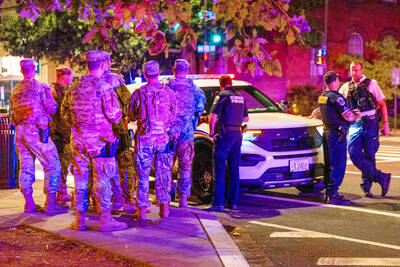
POWER CONFLICT: The US president threatened to deploy National Guards in Baltimore. US media reports said he is also planning to station troops in Chicago US President Donald Trump on Sunday threatened to deploy National Guard troops to yet another Democratic stronghold, the Maryland city of Baltimore, as he seeks to expand his crackdown on crime and immigration. The Republican’s latest online rant about an “out of control, crime-ridden” city comes as Democratic state leaders — including Maryland Governor Wes Moore — line up to berate Trump on a high-profile political stage. Trump this month deployed the National Guard to the streets of Washington, in a widely criticized show of force the president said amounts to a federal takeover of US capital policing. The Guard began carrying
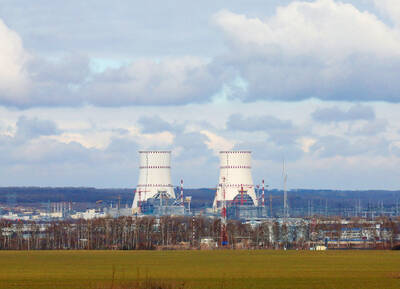
Ukrainian drone attacks overnight on several Russian power and energy facilities forced capacity reduction at the Kursk Nuclear Power Plant and set a fuel export terminal in Ust-Luga on fire, Russian officials said yesterday. A drone attack on the Kursk nuclear plant, not far from the border with Ukraine, damaged an auxiliary transformer and led to 50 percent reduction in the operating capacity at unit three of the plant, the plant’s press service said. There were no injuries and a fire sparked by the attack was promptly extinguished, the plant said. Radiation levels at the site and in the surrounding